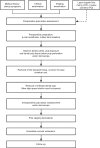Expert consensus on pulpotomy in the management of mature permanent teeth with pulpitis
- PMID: 39762213
- PMCID: PMC11704326
- DOI: 10.1038/s41368-024-00333-9
Expert consensus on pulpotomy in the management of mature permanent teeth with pulpitis
Abstract
Pulpotomy, which belongs to vital pulp therapy, has become a strategy for managing pulpitis in recent decades. This minimally invasive treatment reflects the recognition of preserving healthy dental pulp and optimizing long-term patient-centered outcomes. Pulpotomy is categorized into partial pulpotomy (PP), the removal of a partial segment of the coronal pulp tissue, and full pulpotomy (FP), the removal of whole coronal pulp, which is followed by applying the biomaterials onto the remaining pulp tissue and ultimately restoring the tooth. Procedural decisions for the amount of pulp tissue removal or retention depend on the diagnostic of pulp vitality, the overall treatment plan, the patient's general health status, and pulp inflammation reassessment during operation. This statement represents the consensus of an expert committee convened by the Society of Cariology and Endodontics, Chinese Stomatological Association. It addresses the current evidence to support the application of pulpotomy as a potential alternative to root canal treatment (RCT) on mature permanent teeth with pulpitis from a biological basis, the development of capping biomaterial, and the diagnostic considerations to evidence-based medicine. This expert statement intends to provide a clinical protocol of pulpotomy, which facilitates practitioners in choosing the optimal procedure and increasing their confidence in this rapidly evolving field.
© 2025. The Author(s).
Conflict of interest statement
Competing interests: The authors declare no competing interests.
Figures
References
-
- Ge, L. & Ling, J. Prevalence of pulpal disease and risk indicators analysis in Guangzhou. Chin. J. Stomatol. Res.3, 71–77 (2009).
-
- Yue, L. & Wang, J. Evaluation of therapeutic concept and methods for infected pulp. Zhonghua. Kou. Qiang. Yi. Xue. Za. Zhi.37, 324–326 (2002). - PubMed
-
- Hargreaves, K. M. & Cohen, S. (eds.) Cohen’s Pathways of the Pulp 10th edn (2010).
Publication types
MeSH terms
Substances
Grants and funding
- 82071110/National Natural Science Foundation of China (National Science Foundation of China)
- 82230029/National Natural Science Foundation of China (National Science Foundation of China)
- 82370948/National Natural Science Foundation of China (National Science Foundation of China)
- 82170941/National Natural Science Foundation of China (National Science Foundation of China)
LinkOut - more resources
Full Text Sources
Miscellaneous




